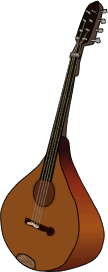Bouzoukis
Created | Updated Jun 14, 2019
Bagpipes
| Bells
| Bodhráns
| Bouzoukis
| Brass Instruments
| Cellos
| Clarinets
| Double Basses
| Drums
| Flutes
| French Horns
| Harps
| Harpsichords
Lutes
| Mandolins
| Ocarinas
| Orchestral Percussion
| Recorders
| Saxophones
| Trombones
| Trumpets
| Violas
Woodwind Instruments - An Overview
| Unusual Musical Instruments

The mainstay of Greek music, the bouzouki, is a stringed instrument with a pear-shaped body and an enormously long neck. The bouzouki is a member of the 'long neck lute' family and is similar to an oversized mandolin. The front of the body is flat and is usually heavily inlaid with mother-of-pearl. The instrument is played with a plectrum and has a sharp 'twangy' sound.
Modern bouzoukis have eight metal strings which are arranged in four pairs, known as courses. In the two higher-pitched (treble) courses, the two strings of the pair are tuned to the same note. These are used for playing melodies, usually with the two courses played together. In the two lower-pitched (bass) courses, the pair consists of a thick string and a thin string tuned an octave apart. These 'octave strings' add to the fullness of the sound and are used in chords and bass drones (continuous low notes that are played throughout the music).
The traditional tuning for the four-course bouzouki is C3F3A3D4 (where C4 is Middle C). This makes it the same tuning pattern as the first four strings on a guitar, but pitched down a whole tone. In recent times, some players have taken to tuning their bouzoukis up in pitch to D3G3B3E4, which is the same exactly as the first four strings of the guitar, making it easier to play both instruments.
History
Despite being the one Greek instrument that everybody recognises, bouzoukis have not been around in Greece all that long. As recently as 1920, they were relatively unknown. They were common in Turkey, though, belonging to a tradition of long neck lute instruments bearing various names such as Saz, Tambour and Bouzouk. The west coast of Turkey in the early decades of the 20th Century was a blend of different cultures, with Greek-speaking, Turkish-speaking and Armenian-speaking people, Christians and Muslims all mixed together. As part of the settlement at the end of the Graeco-Turkish War (1919 - 22), it was agreed at government level (the Treaty of Lausanne) that Christians living in Turkey were to be deported to Greece while Muslims living in Greece were packed off to Turkey. This 'voluntary exchange of population' left many Christian Turks arriving in Greece with nothing but their bouzoukis and living in slums around Athens. These people brought with them the music known as 'Rembetika'.
The early bouzoukis had three courses (six strings in three pairs) and were generally tuned to D3A3D4. This tuning fits in well with the music of the Middle East, as an open chord is neither major nor minor, allowing great flexibility with the melody.
After the Second World War, four-course bouzoukis started to appear. History does not record exactly who it was who first thought of adding the fourth course. Some bestow the honour on a banjo player called Stefanakis, while others say it was Anastasios Stathopoulos. All agree, however, that the four-course bouzouki was made popular by the brilliant playing of Manolis Chiotis. His amazing virtuosity encouraged others to take up the four-course bouzouki and very soon it became the instrument of choice for Greek music.
Traditional Greek Night at the Tourist Resort
Not everyone is enamoured of the direction Greek music has taken. Like bagpipes, tartan and shortbread in Scotland, it presents a 'standardised view' of the tradition of the country which is considered suitable for the tourists but is only a part of the real Greece. Crete, for example, has a thriving tradition of music based on the lyra, a type of bowed fiddle. You won't find this music in the tourist resorts, but it is still played in the real Greek towns, for Greek people only. Meanwhile, the professional bouzouki players enthral the tourists with their show-off dexterity. The case for a return to the roots of the music is presented brilliantly by the Radical Movement for Rebetiko Dechiotification and Bouzouki Detetrachordization, who call for the reinstatement of the traditional three-course bouzouki.
Bouzoukis in Irish Music
Some time in the 1960s, an Irish musician called Johnny Moynihan brought his first bouzouki, a four-course model, home from Greece and used it in the band Sweeney's Men. He thought 'its plangent quality suited Irish music'. His fellow band members were initially not impressed: it kept going out of tune and didn't fit in. He persevered and it became clear that bouzoukis suited Irish music much better than the acoustic guitar. Moynihan soon abandoned the Greek tuning and switched to G2D3A3D4 which ironically is closer to the original Greek instrument than modern Greek ones are.
Soon, musicians Andy Irvine and Dónal Lunny started to use them too, popularising them in such trad groups as Planxty, The Bothy Band and Moving Hearts. They made a few changes, though, to make them fit in better. Irish music relies less on virtuoso melodies played on double courses, and more on the bass courses, so they got rid of the octave strings which only confuse things and replaced them with pairs tuned to the same note. They used much heavier strings at higher tension for extra volume. To cope with the extra tension, they commissioned sturdier flat-backed instruments with metal reinforcement in the neck. The bouzouki is now an important part of the Irish trad scene.

